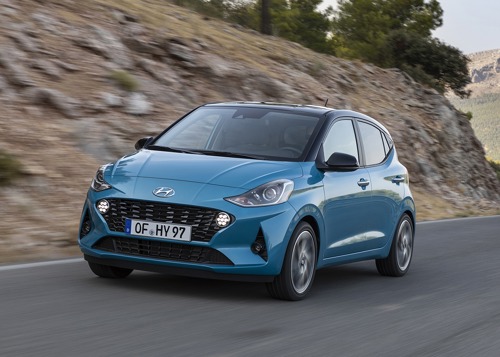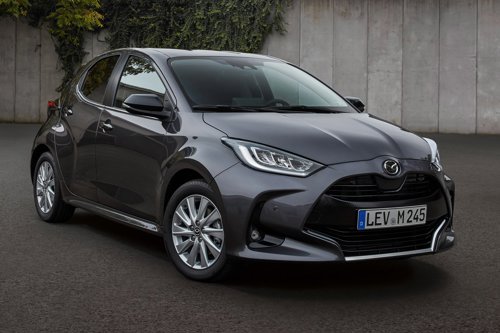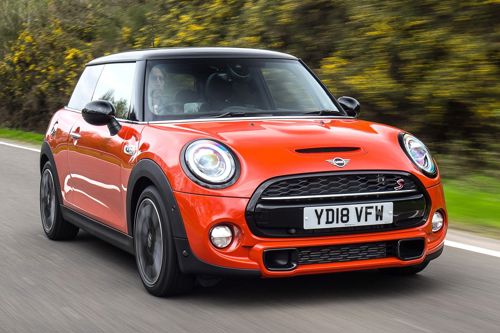Quick overview
- City-busting size
- Still looks great
- Easy and fun to drive
- Cramped rear seats
- Tiny boot space
- Not as settled on motorway as some rivals
The Fiat 500 might have started out as a retro-themed city car that took its inspiration from the 1957 original, but it’s become a modern classic in its own right. First offered in the UK in 2008, the 500 has changed subtly in many ways over the years, and there’s also a full electric version with its own unique looks and drivetrain. For this petrol-fuelled model, which also comes as a Convertible with folding canvas roof, Fiat now uses a 1.0-litre petrol engine with mild hybrid technology to keep it in the hunt for city dwellers’ business.
The Fiat 500 is definitely at its best around town, where the compact dimensions mean it can bob and dive through congested streets with blissful ease. All of the controls are light to use and there’s just something so essentially right about the feel of this car as it nips along. It’s just right – not too quick, not too slow, just the right size, and with a shot of style that’s like a welcome espresso every time you drive it.
There are drawbacks to the Fiat 500, though. Its small size means the cabin is really only fit for two people, with the rear seats merely adequate for very young children. The boot is similarly afflicted and makes even a Mini seem like a generous load lugger. There is also the small matter of the Fiat’s dynamic ability, which was fine when the car was first launched in 2008 but now lags well behind the class best.
However, all of this will not stop plenty of people choosing the Fiat 500 on its looks alone, and it is a very attractive small car. Inside, there’s more tech and comfort than ever before, so it’s not all outdated with the 500, and anything that makes you enjoy driving has to be a good thing.
Infotainment, comfort and practicality
The overall architecture of the Fiat 500’s cabin has not changed, despite more than one update and facelift in its long production life. As a result, the cabin offers no more space than it did when the car was first unveiled back in 2008. This means the driver and front passenger are offered sufficient space to feel comfortable and not be rubbing shoulders as they head off. There’s also a good amount of leg and headroom in the hatchback model for those in the front, but the entry-level trim does without driver’s seat height adjustment. Fiat also only allows the steering wheel to be adjusted for angle, not reach, which can force a compromise between arms and legs.
From the driver’s seat, all-round vision is good, helped by the diminutive scale of the 500. Rear parking sensors are standard on all but the entry-point Pop trim, though you can almost peer over your shoulder and see the rear bumper in the Fiat. Turning attention back to the dash, the gear lever sprouts out of the middle of the main console, so it sits high and close to your left hand. There’s also a button next to the gear shifter that you can press to lighten the steering assistance when parking. In front of the driver, the main binnacle could be a little clearer to read as the speedo is teased round the edge of the dial, while in the middle is a digital display for various functions such as fuel level and engine temperature. However, it does look very stylish.
In the middle of the dash, there are simple rotary controls to operate the heating and ventilation. They are magnificently simple to understand and it makes you wonder why a car maker would opt for anything else. Every 500 now comes with air conditioning of some description, so it’s quick to demist on frosty mornings or cool when it’s warm outside. The Pop model comes with a 5-inch display screen as standard to work the stereo and it has Bluetooth to link with your phone for hands-free calls. Move up to the other trim levels and this is improved to a 7-inch touchscreen that works with Android Auto or Apple CarPlay. It’s well positioned to be withing easy reach and the graphics are clearly read, though it can suffer from glare in bright conditions.
Tip the front seats forward and you might wonder how anyone is going to fit in the back of the Fiat 500. There is enough room for two kids to sit back here, but that’s about your lot Adults will find it much too cramped to travel any further than very short hops. There are also Isofix child seat mounts in the two rear seats, though lifting your beloved into their seat will be a challenge for your lower back due the narrow gap through the doors and over the front seat when it’s tipped forward.
The rear seats are better viewed as supplementary storage to the 185-litre boot. It’s small even by city car standards, but the rear seat split 50-50 and tumble forward. However, this still leaves a step in the boot floor and maximum capacity is 550-litres all in.
2008 Fiat 500 engines: how does it drive?
The Fiat 500 comes with the mildest of mild hybrid systems. It means there’s no electric-only driving on offer, you cannot plug it in to recharge, and there’s no discernible assistance to performance from the battery as you drive along. However, it does allow the engine to switch off as you coast to a halt and press down on the clutch pedal, harvesting this energy that would otherwise be lost to top up the small battery. The end result is a combined economy claimed at between 60.1- and 61.4mpg depending on which trim of 500 you choose.
While the electric side of the Fiat’s hybrid power doesn’t make any obvious contribution to the acceleration of the car, it still gets from a standstill to town speeds in a brisk fashion. The six-speed manual gearbox has a short shift between gears and is light enough to be used without any thought around town. This is helped by the light clutch pedal and steering that has just enough weight and feedback in normal city conditions. It can also be lightened up at the touch of a button to gain more assistance when parking. You also get rear parking sensors in all but the base Pop trim, so there’s scant excuse for not being able to slot the 500 into the smallest of parking spots.
On faster stretches of road, the 1.0-litre three-cylinder engine, which generates 70hp, can take the 500 from rest to 62mph in 13.8 seconds. As a consequence, it’s noticeably slower at getting up to the national speed limit than rivals like the Hyundai i10 or Volkswagen Up with similar power outputs. Compensating for this to some degree is the willingness of the Fiat’s engine to rev without becoming too noisy or tiresome at greater speeds. Even so, there are other city cars that are better all-rounders and are more suited to long journeys than the Fiat 500.
When negotiating the urban jungle, the 500 is at its happiest and it can make the most of its small size to zip through gaps. You’ll find the ride is quite bouncy, though, so you quite often have to take avoiding action at the sight of larger potholes or ridges. It’s a similar story on the open road, where the ride is not as settled or absorbent as a Kia Picanto’s, but it’s also never uncomfortable enough to put you off using the car. When you do, you’ll also find it has nippy handling with enough grip to be enjoyable when the road ahead is free of other traffic. It’s a pity, then, the steering doesn’t have a lot of feel or connection with what the front wheels are up to. For that, you need an Abarth version of the 500. When you get on to quicker dual carriageways or motorways, however, there is more road and wind noise than in the Fiat’s main rivals.
Value for money: how much does a 2008 Fiat 500 cost to buy and run?
There’s a very simple pricing structure for the three main trim levels of Fiat 500, especially as all of them come with the same engine and gearbox configuration. The range starts with the Pop model that costs from £14,675. From there, you move up to the Dolcevita, which is £1500 more at £16,175. If you prefer the Dolcevita Plus, it’s another £1500, so it comes in at £17,675. Bucking this trend is the 500 RED, which costs £17,175 and helps support the RED charity. A bit of legwork on the internet can net you a saving of up to £2000 on the price of a brand new Fiat 500 Hybrid. Shop for a nearly new example and you can save as much as £4000 for a car with less than 5000 miles on the clock and less than a year old. A three-year old Fiat 500 Hybrid with typical mileage will come in at around £9500.
With the Fiat 500 Pop, you get red paint as the only no-cost choice, along with 14-inch steel wheels, plain fabric upholstery, and a 5-inch audio display in the centre of the dash. The Pop also has air conditioning, but after that you really need to spend on optional extras to improve specification. As a result, the Dolcevita is a better bet as it comes with 15-inch alloy wheels, rear parking sensors, and the 7-inch infotainment touchscreen. It has a sunroof, too, as well as cruise control and two-tone white and black upholstery to look a lot smarter. Choose the Dolcevita Plus and it adds 16-inch alloy wheels, sat-nav, and climate control in place of air conditioning. As for the RED version, it has unique black upholstery, red-painted door mirror covers and front grille bar, and 15-inch alloy wheels with red centre caps.
Owning any of these 500 Hybrid models will not tax your finances too much thanks to average fuel economy of 61.4mpg for the Pop and Dolcevita Plus models, while the Dolcevita and RED come with combined consumption of 60.1mpg. The Pop emits 105g/km of carbon dioxide, while the other three produce 106g/km. As a result, they all pay £170 for first-year road tax, followed by £165 for subsequent years at current tax levels.
Verdict: Should I buy a 2008 Fiat 500?
The Fiat 500 Hybrid is a car that many drivers will already have decided to own regardless of considerations such as performance or practicality. On both of these counts, there are better city cars out there, and the evidence is generally stacked against the Fiat on most objective counts. Yet, there is still a lot to draw in buyers thanks to the Fiat’s cute looks and low running costs, helped by the mild hybrid power.
There is a feel-good factor to owning and driving the Fiat 500, and it still cuts a dash around town even if it’s been in production since 2008. That’s a mark of the car’s essential rightness of design. However, if you need to carry more than one passenger or decent amounts of luggage, or travel further than the suburbs regularly, the Fiat is a less appealing prospect.
What could I buy instead of a 2008 Fiat 500?
Hyundai i10

If you want to be all sensible about choosing a city car, the Hyundai i10 is about common sense as it gets. Yet, the i10 is also a striking car to look at and good to drive thanks to its peppy engine and slick manual gearbox. It also handles well and is much more refined on long trips than the Fiat. Throw in a good spread of standard kit and the Hyundai is a very strong contender for any townie’s business. The only small disappointment is prices for the i10 have crept up over the past few years.
Mazda 2

Yes, the Mazda 2 is a supermini and the Fiat 500 is a city car, but the Mazda is a very stylish choice and there’s also a hybrid model on offer. Affordable to run, the Mazda is as much fun around town as the Fiat 500 Hybrid yet it’s also much more capable on longer trips on the motorway. However, like the 500, faster roads show up the Mazda’s poor high-speed refinement. The well-made cabin is a comfortable place for those in the front, and the boot is decent for its class, but rear passengers might find it a little tight on room.
Mini 3dr

It’s hard to think of the Fiat 500 without mentioning the Mini. Not only are the two arch rivals going back to the 1950s, this pair are the best examples of retro design done splendidly well. The Mini has developed into a whole brand, with many different models filling various classes, but the three-door hatch remains the core product and it’s an absolute belter to drive. It handles supremely well and if more refined than the Fiat. Like the 500, there’s an all-electric version, but don’t discount the petrol models for driving pleasure and wallet-pleasing running costs.



.JPG?rmode=crop)
.JPG?rmode=crop)
.JPG?rmode=crop)
.JPG?rmode=crop)
.JPG?rmode=crop)
.JPG?rmode=crop)
.JPG?rmode=crop)

